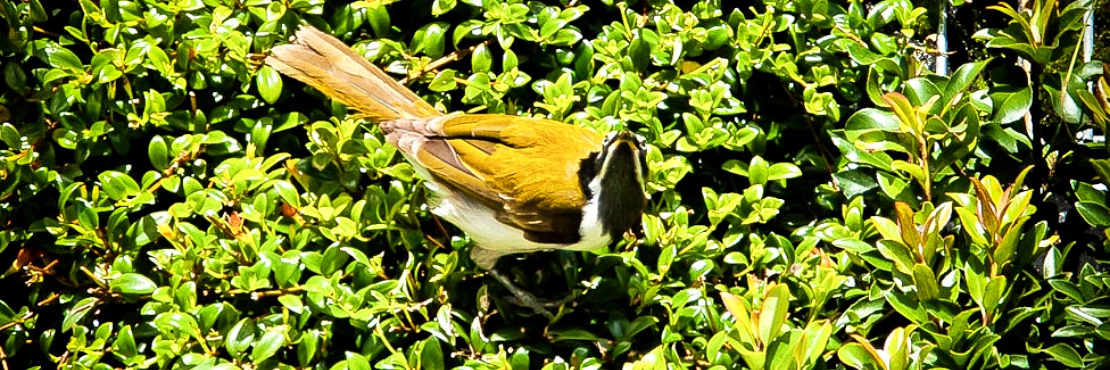Imagine being a bird or insect, birthed in a remnant habitat, close to shelter, water, and food sources, shaded and protected by vegetation, within a diverse and well populated food web nurtured by a healthy environment.
Taking to the air, you fly into the breeze, seeking out a space to enter the outer world, your instincts luring you to follow a hereditary migratory pathway that is genetically encoded and entrusted to you to carry forth as a map to ancient habitats that are perfectly developed to host your offspring an a manner that only aeons of repeated, reliable, adaptive conditioning, achieved.
Yet, rather than verdant fields, scrubland, forest, and all manner of natural habitats, you contact obstacles such as roads, trucks, busses, dense populations of humans; glass; concrete and steel-clad buildings; scorching hot asphalt; bone dry surfaces stripped and maintained clear of any life-giving or sustaining resources, water, or shelter.
Local birds are starving or malnourished, exhibiting aggressive behaviour to secure scant meals whilst general species diversity is significantly low. Only the toughest, most aggressive and generalist of species becoming dominant.
Appropriately designed vertical garden technologies offer opportunity to convert our harsh cities into receptive, responsive, resilient, dynamic, and adaptive human habitats, empowered by nurturing ever increasing species diversity.
You’re faced with large populations of only a handful species within your flight through these barren constructions, which the city currently hosts as monoculture pest species that only the most pared-back and low-functioning of habitats might sustain, the “pests” of the city, each hungry for survival and desperate to compete over scant resources.
How are you to find food, a mate, a resting or nesting space, safety, water or respite from the stresses and threats of human-centric, constructed zones? How to survive a mere attempt to navigate the persistently disturbed and changing, harsh, environment to access suitable habitats, if such remain on the other side?
Urban parkland may seem to be fantastic spaces for wildlife, though this is often not the case. Where humans are, disturbance and stress present, for wildlife. Urban parks are generally designed for human comfort and safety, not wildlife services, thus species selections are generally aesthetic, offering low diversity, “commercial” planting densities and planting arrays catering for aesthetic rather than functional, wholesome, and holistic ecological, services.
The maintenance of urban parks and general plantings are often conducted by generalist horticultural staff, for businesses functioning on a highly competitive basis, thus weed control is chemical in nature, often moderately haphazard, tending towards species attrition and loss over time due to overspray and poisoning, whilst pruning is expedited and mechanical, turf areas predominate, frequently functioning as barren monocultures.
Consequently, our native species require urban, vegetated, installations to be developed appropriately should they be expected to function as natural resources. Such targeted intention and design do not perform as hoped-for, unless councils and managing agencies are prepared, suitably educated, highly skilled in the various subjects and skillsets required to synchronise, appropriately fund, manage and structure, to apply and coherently uphold specialist design and ongoing sustainable maintenance of such installations.
Establishing Healthy Urban Cultural Habitats
The outlook seems somewhat bleak, until we reach a point where our cultures are sufficiently mature and appropriately educated, to value natural resources as part of our human habitats and our human habitats as part of what makes us healthy human species.
Non-human species are not guests in human habitats, they are integral parts thereof, highly functional constituent components that render habitats integrated and thus sufficiently dynamic to be responsive and functional and sustainably productive. Diversity is a key, functional, component of the structure of healthy and responsive systems.
Consider each species as a cog within the living machine of ecology
The fewer dynamic components (species) a system has, the fewer responses the system can generate or sustain.
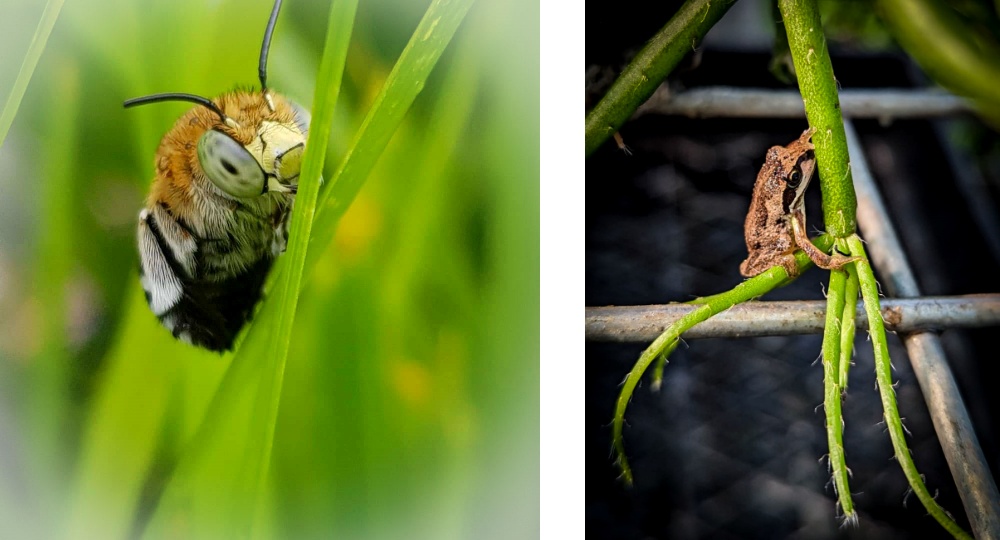
There is a correlation between species diversity and the diversity of impacts upon a living system, that system can respond to. Thus, the progression towards higher diversity, expands a systems capacity to respond to stressors, generate change, support such change and therefore cope. Species are the moving parts of living systems, generating, using, and moving resources and energy-flows into-, through, and out of systems. Humans are one such species within our living habitats, thus our built habitats need to incorporate as much species diversity as possible, if they are to cater for the increase or decrease in resources and wastage we produce, without a constant requirement for human-driven inputs to maintain system health. Living systems are resources we can use or lose.
It is the action of all species within processes of sustainable integration that render human-used spaces healthy habitats. Our ecologies rely upon community to gain wholesome and comprehensive support towards developing resiliency.
Vertical gardens and non-trafficable roof gardens are uniquely identified, with significant benefit, to function as potential refugia for species attempting to co-habit and migrate through our urban, human-centric, constructions. Many parklands retain a high level of disturbance simply due to the presence of humans and the resultant human contact attrition that takes place, and as such, they might provide a limited capacity to support only the most hardy and resilient of species.
Commercial and Residential Habitat Types
Most private & commercial properties frequently host periods of lower levels of human activity, either during business, late night, and early morning hours, potentially providing periods of uninterrupted rest and activity for fauna. The nature of commercial endeavours where humans spend most daylight hours away from home, whilst predominantly engaged inside working spaces, may support daytime animal activity whilst the closing of most businesses at nighttime, may support nocturnally active species. The addition of a single cat or dog to urban gardens (species that are genetically programmed to range over large areas) can significantly reduce an urban gardens capacity to support a wide range of species.
Vertical gardens are unique in this manner, their vertical orientation offers opportunity to support a wide range of species, those sensitive to predators typical of terrestrial habitats as well as species sensitive to human proximity. Pollinators, birds, and insects may access such spaces, seek resources, protection and respite day and night. Thus, when utilised in combination with terrestrial habitats, we find sympathetic design capable of expanding ecological functioning despite human activity rhythms.
Vertically Orientated Habitats
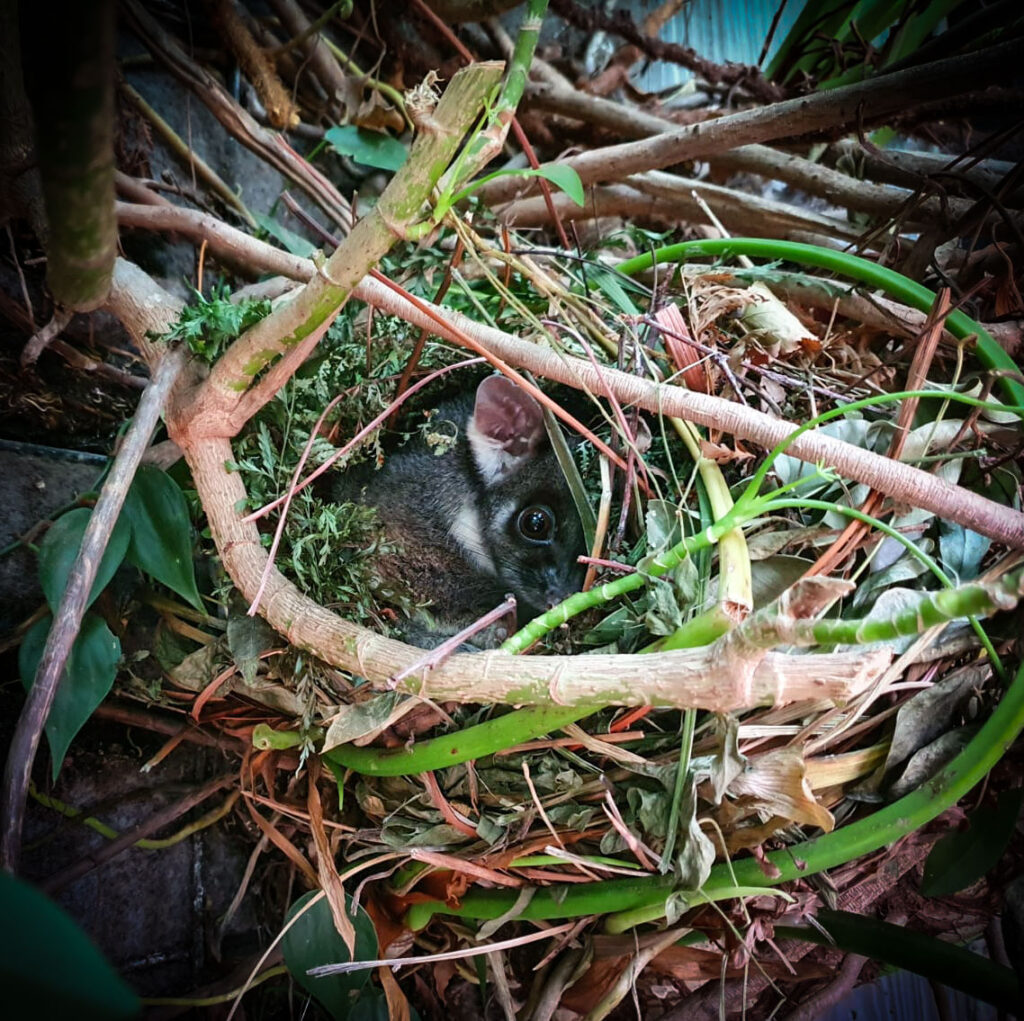 Many exotic and native plants may host, support, and sustain a diverse range of native, urban-based, species. This is most notable for vascular flowering plants offering pollen, nectar, fruit and seed, foliage, and refuge to a wide range of species assisting with developing a stable food web. Though, such scenarios only function well when the areas also offer ambient conditions conducive to wildlife entering the spaces, thus respite from close proximity to human activity, as well.
Many exotic and native plants may host, support, and sustain a diverse range of native, urban-based, species. This is most notable for vascular flowering plants offering pollen, nectar, fruit and seed, foliage, and refuge to a wide range of species assisting with developing a stable food web. Though, such scenarios only function well when the areas also offer ambient conditions conducive to wildlife entering the spaces, thus respite from close proximity to human activity, as well.
This may not apply to vertical garden systems and planting designs requiring cyclic replanting or planting configurations and species selections generating reduced ecological services.
A step further are the ecological niches vertical gardens, which are inherently undisturbed spaces, offer. The vertical orientation of vertical gardens or living walls, present notable ecological service options to a range of species, if precluding human access or limiting it to only the occasional maintenance session. Many species require specific habitat types, with vertically orientated habitat offering support to both pest and prey. Many raptors prefer perching and nesting sites at height, with the associated hunting benefits. Conversely, many seed, nectar and fruit-eating bird species seek defensive benefits from overhead predator attack, thus foliage coverage overhead, or foraging sites away from flat or horizontal surfaces.
Nesting sites within urban settings may be scarce, highly disturbed, and potentially unsafe for most species. Extreme weather is becoming a notable disturbance event for wildlife, exacerbated in cities. Vertical gardens offer vegetated nesting sites, inclusive of short-day active sun impacts on east- and west-facing garden orientations. North and South-facing orientations offer either warmer winter or cooler summer exposures. Overhanging vegetation and close proximity to food and moisture are vital factors, where resources within the urban sphere are mostly fractured, widely dispersed, hence lacking inter-connection.
The benefits of vertical garden and roof garden installations extend by a considerable margin to commercial installations, notably on high-rise buildings offering significant opportunity for migratory species to access them either temporarily or for protracted use.
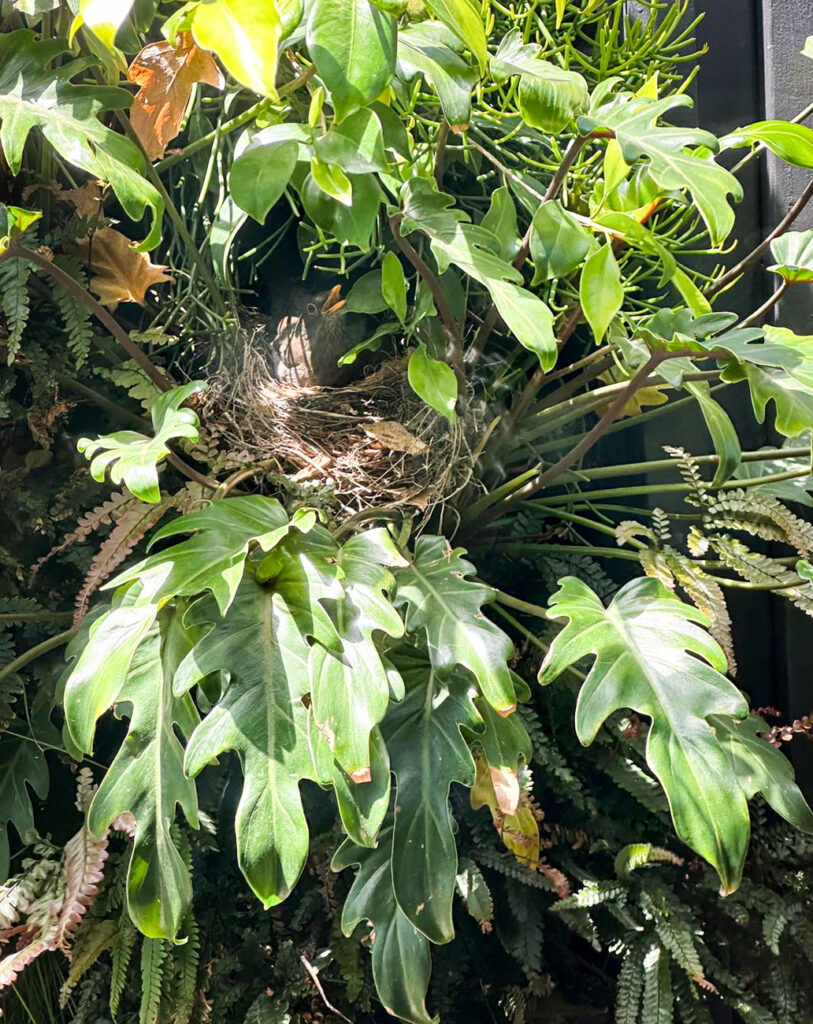 Vertical gardens may function as refugia to both fauna and flora species, as do cliff-faces and remnant habitats away from the hands and activities of human, general weather, storm, and fire disturbance. In well-integrated cities, they may perform as habitat mosaics, in many cases functioning as wildlife corridors for those species capable of traversing aerial ecologies. This is, unfortunately, not always the case for terrestrial species on the horizontal plane within the general landscape, where the urban sphere is simply too congested with land valued with a bias towards intensive human use.
Vertical gardens may function as refugia to both fauna and flora species, as do cliff-faces and remnant habitats away from the hands and activities of human, general weather, storm, and fire disturbance. In well-integrated cities, they may perform as habitat mosaics, in many cases functioning as wildlife corridors for those species capable of traversing aerial ecologies. This is, unfortunately, not always the case for terrestrial species on the horizontal plane within the general landscape, where the urban sphere is simply too congested with land valued with a bias towards intensive human use.
Vertical garden are capable of supporting thousands of plants across a diverse range of species, on a minuscule footprint of potentially a single foot or mere centimetres. As a result, a vertical garden could host an entire forests worth of plants including the associated species diversity, vertically, over a highly trafficable area, at no cost to building or city floor space.
The closer we are to where human activity abounds, i.e., ground-level, the greater the level of human disturbance presents, thus aerial zones, namely spaces humans mostly access visually rather than physically, are also largely undervalued and under-used.
Most high-rise buildings offer large, mostly underutilised, vertical surface areas. These spaces could be used to support healthy, natural systems and ecologies. Furthermore, they could be value added to, by utilising vertical garden systems capable of processing pollutants, such as wastewater generated by human activity within the host buildings. Stacking such functions, is a quintessentially ecological process. Foliage layering, root system layering, habitat layering, nutrient and water purification and resource re-use, are signatures of healthy systems.
These aerial spaces are invaluable assets for our cities and our conservation efforts where the benefits of creating resilient, adaptable, diverse and functional habitats, across such spheres of development, offer extremely broad (and extended) benefits to not only local use though the wider landscape.
Commercial and Ecological Value of Urban Habitats
Humans are hard-wired to respond favourably, both physiologically and psychologically when accessing natural scenes. This has been discussed in previous blog posts, whereby our health and wellbeing are notably improved even if only visual access to scenes of natural vegetation are available.
It is innate to us to feel calmer, bathed in safety and comfort, when viewing natural scenes offering healthy brain interactions. This stimulates hormone regulation, with resultant beneficial impacts on our health and wellbeing.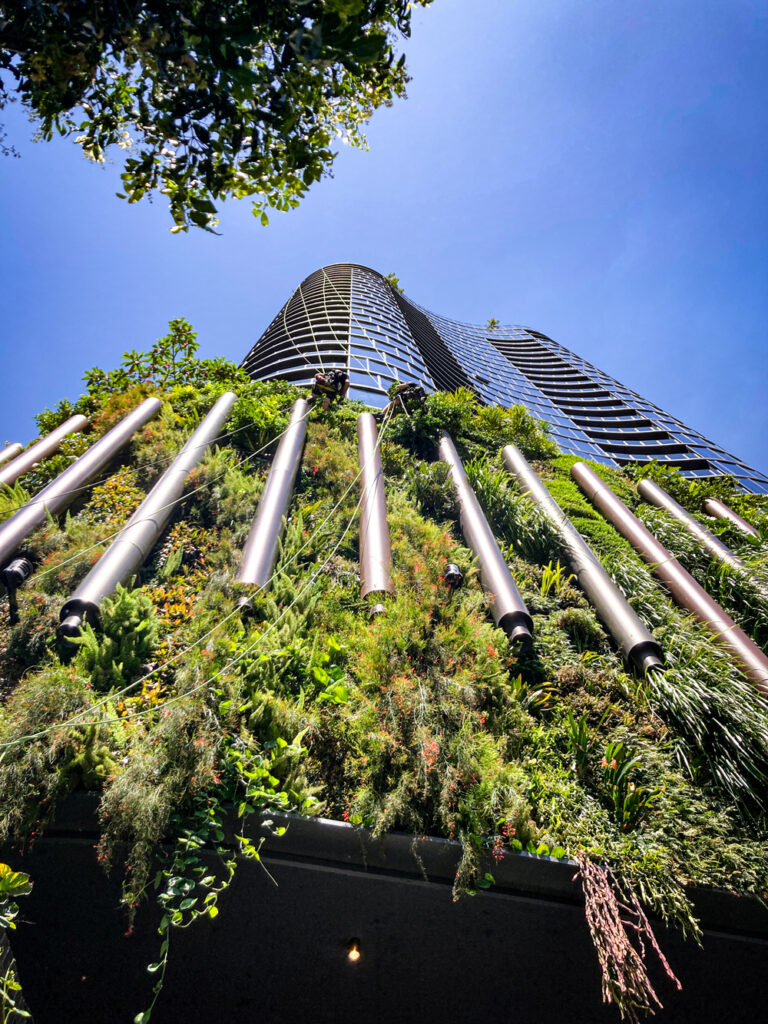
Commercially this is vital in the urban sphere, considering vertical garden or roof garden installations offer significant property value increases, a sense of beauty and increased consumer interest. This extends to neighbouring buildings with direct visual access to such installations. Consider, when purchasing or selling a property clad in verdant, beautiful, foliage with fascinating or calming natural installations, the perceived value of host buildings is rendered higher to the investor and tenant, alike. Yet should one view an apartment in a neighbouring building with windows maximising views directly facing such a mesmerising and unique installation, the value of the neighbouring apartment will naturally increase simply due to proximity.
Thus, the value of living within cities offering policies and incentives to maximise living architecture as natural assets, automatically increases for investors and tenants, as perceived liveability enhances their value as commercial assets.
When such installations are designed to actively support healthy ecological functioning, catering for a diverse range of transitory and permanent species across the urban sphere, a notable improvement ensues. Cities with active and healthy ecological functioning, reduce harsh exposures, reduce pollution, increase diversity, increase dynamic adaptability and vegetation resiliency, reduce monocultured pest and disease influx, and cumulatively increase potential functionalities humans place great value on. Cities are human habitats.
Requirements for Appropriate Expertise
Human habitats require receptiveness, sensitivity, and specialised understanding of species diversity to remain functional, resilient, and adaptable, though achieving such requires specialised understanding and design skill expertise, to see this realised, sustainably.
General residential gardens and urban parkland may offer benefit to persistent and migratory wildlife, though to extend ecological services to provide greater benefit to a wider range of species, all of which are entirely reliant upon us to offer support, we require design processes to target appropriate habitat production that empowers such installations to function as refugia.
Simply placing terrestrial plants species on vertical surfaces does not automatically provide appropriate ecosystem services to migratory invertebrates and birds. Remnant habitats, and designed ecologies alike, require specialist knowledge to design, maintain and sustain, which is exacerbated by the vertical plane. There are an overwhelming plethora of species around the world that have evolved specifically within vertically orientated habitats, with remarkable adaptations to survive and thrive within the associated vertically orientated ecologies. These are highly complex assemblages of species capable of rapidly altering the exposures they colonise towards ever increasing densities and diversities. Understanding this requires highly specialised knowledge, fields of expertise rarely encountered within the general garden and landscape design spheres.
This area of expertise encompasses fascinating and potentially very productive areas of development for professionals, researchers, and educators, alike.
It’s incumbent upon us to prioritise these areas of expertise, ensuring vertical garden & roof garden technologies are wielded in an appropriate manner that maximises their ability to offer much needed, expanded, ecological services within the urban realm. This will stimulate policy to maximise their potential, whilst simultaneously directing the living architecture industry to focus upon developing and applying system types that are capable of hosting appropriate, permanent, vegetation solutions able to support and sustain healthy, long-term, ecological services.
Appropriately designed vertical garden technologies offer opportunity to convert our harsh cities into receptive, responsive, resilient, dynamic, and adaptive human habitats, empowered by nurturing ever increasing species diversity.
Healthy people are denizens of healthy habitats, healthy habitats generate healthy people and cultures. I hope we may start looking upwards and outwards from our constructed habitats, and see the potential inherent to vertical gardens, to act as refugia for a wide range of species, though also refugia for pragmatic, holistic and dynamic thinking.
Integrating wildlife into our human habitats, provides medicine, nourishment and valuable resources to systems offering resiliency, adaptability, and healthy outcomes.
Vertical gardens offer the potential for us to channel these benefits upwards and across our homes, industries, and cities.
~ Erik van Zuilekom

Erik van Zuilekom is Fytogreen’s in-house Botanist and a species selection & design specialist – vertical garden & living architecture applications. Offering astute design & assessment expertise for the production of adaptive, robust & resilient (designed) ecologies. I would like to see green life ecologies deeply integrated into the urban fabric & psyche, not as passive claddings, rather as responsive technologies.
Fytogreen is Australia’s leading green infrastructure specialist and technical knowledge is gained from its targeted research and development process. Fytogreen is fortunate to be a leader in this field, with experience gained through exposure to an extensive diversity of applications, coupled with long-term monitoring of these installations.
Follow Erik on Instagram – United Natures Design
If you have a specific topic your would like covered by Erik or have any comments, please email lisa@fytogreen.com.au
 Greenroofs.comConnecting the Planet + Living Architecture
Greenroofs.comConnecting the Planet + Living Architecture
